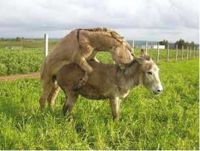Male Sexual Behaviour - Donkey

Sexual behaviour is slightly different from the horse with regard to time of erection and mounting. Jacks seem to have a slower copulatory response especially when breeding with mares for mule production (Gastal et al ,1996; McDonnell, 1998; Tibary, 2006).
Jacks are described as territorial. Each jack has a territory where breeding with solitary females takes place. They defend their territory against any adult males, particularly in the presence of oestrous jennies. They typically interact with jennies in a series of brief episodes, interrupted by a retreat to their resting area.
The pre-copulatory sequence includes vocalization within the resting area, approach and teasing of the sexually active group of jennies, followed by retreat and then sudden approach and brief teasing or mounting. This behaviour may be repeated several times before the jack retreats again to the resting area where erection is achieved before he immediately approaches a jenny and copulates quickly without pre-copulatory behaviour. The precopulatory behaviour sequence includes nose-to-nose contact, nibbling and/or sniffing of the head, neck, back of the knee, body, flank, perineum and tail, olfactory investigation of voided urine or faeces and flehmen.
Achieving an erection at a distance from the jenny is one important characteristic of breeding behaviour. Spontaneous erection and masturbation occur at the same rate as in the stallion with an episode every 90 minutes (Tibary, 2006).
When observing free-ranging jacks, insertion latency, the number of thrusts and the total time mounted has been described as similar to that of stallions. However, in a hand-mating situation and in particular in situations of mule production (jacks breeding with mares) our experience has been that all jacks take an extremely long time until erection and mounting, but once mounting is achieved, ejaculation is generally easily obtained (Tibary et al, 2005; Tibary, 2006).
Literature Search
Use these links to find recent scientific publications via CAB Abstracts (log in required unless accessing from a subscribing organisation).
Donkey mating behaviour publications
References
- Tibary, A., Sghiri, A. & Bakkoury, M. (2008) Reproduction In Svendsen, E.D., Duncan, J. and Hadrill, D. (2008) The Professional Handbook of the Donkey, 4th edition, Whittet Books, Chapter 17
- Gastal, M.O., Henry, M., Beker, A.R., Gastal, E.L., and Goncalves, A. (1996). ‘Sexual behavior of donkey jacks: influence of ejaculatory frequency and season’. Theriogenology 46. pp 593-603.
- McDonnell, S.M. (1998). ‘Reproductive behavior of donkeys (Equus asinus)’. Applied Animal Behaviour Science 60. pp 277-282.
- Tibary, A. (2006). ‘Normal and abnormal behavior in the male equine’. Current Therapy in Equine Reproduction, J.C. Samper, A. McKinnon and J. Pycock (eds). Saunders, in Press.
- Tibary, A., Bakkoury, M., Anouassi, A., and Sghiri, A. (2005). ‘Examen et évaluation de l’aptitude à la reproduction’. Reproduction Equine Tome II: L’ Etalon. A. Tibary, M. Bakkoury (eds). Actes Editions, IAV Hassan II, Maroc, 2005. pp 167-174.
|
|
This page was sponsored and content provided by THE DONKEY SANCTUARY |
|---|
